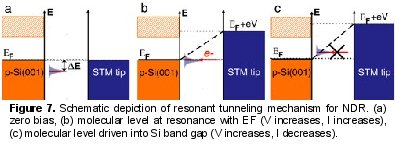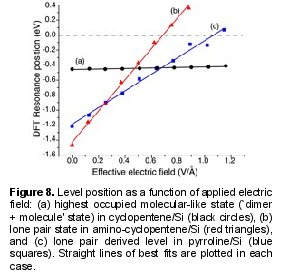Negative differential resistance in hybrid organic-Si molecular junctions
Foundry Users: Su Ying Quek, E. Kaxiras, Harvard University
The ability of aromatic molecules to form well-defined covalent contacts with silicon make them extremely promising for integration with current microelectronics technology, and has led to a growing interest in silicon-based molecular electronics. Recent ultra-high vacuum scanning tunneling microscopy (STM) studies of individual cyclopentene molecules on p-type hydrogen-free Si(001), a prototypical organic-silicon system, reported negative differential resistance (NDR) at 80 K, associated with a critical applied field of about 0.37 V/Ã… . These measurements are strikingly consistent with a resonant tunneling model proposed prior to the experiments. In contrast, independent STM studies performed at room temperature and on n-type substrates report that the cyclopentene molecules desorb, resulting in hysteresis. Although the sample temperature and dopant type differ in the two studies, the contrasting conclusions have generated considerable debate over the origin of the NDR observed for the cyclopentene/Si(001) and related systems.
NDR is a nonlinear transport phenomenon in which the current through a molecule suddenly decreases as the voltage increases. Rakshit et al suggested that a semiconductor-molecule-metal junction can give rise to such a phenomenon. To illustrate. consider a molecule bonded to a p-type semiconductor with a well-defined resonance positioned DE below the Fermi energy EF, the Si valence band maximum (VBM) (Fig. 7a). Initially, this level does not contribute to the current. However, a positive substrate bias causes the molecular level to move upward toward EF. When the level eventually aligns with EF, resonant tunneling through the molecular state occurs, resulting in a sharp increase in current (Fig. 7b). A further increase in bias lifts the level into the band gap. This prohibits carrier flow through the molecular state, resulting in a drop in current and NDR (Fig. 7c). This resonant tunneling mechanism derives from intrinsic adsorbate levels, suggesting the possibility to tailor transport device properties through molecular design.
In collaboration with Foundry user Efthimios Kaxiras at Harvard University, we have used both density functional theory and a many-electron GW self-energy approach to quantitatively assess the viability of this mechanism in prototypical hybrid organic-Si molecular junctions. For cyclopentene on p-type Si(001) , we find that the reported NDR cannot be directly linked to the intrinsic electronic levels in the molecule. This is conclusion follows from Fig. 8, where our calculations show that the molecular-like state closest to the VBM is not pushed into the gap for fields of up to 1.2 eV/A. However, we discover a set of molecular systems related to cyclopentene where the proposed mechanism for NDR is possible (see the red and blue curves in Fig. 8, which illustrates that molecular levels in these systems do move across the VBM and into the gap). These systems incorporate nitrogen atoms with electron ‘lone pairs’. Examples are amino-cyclopentene or pyrroline on silicon. Our results have allowed us to determine guidelines for the rational design of molecules that can exhibit NDR through resonant tunneling.Publications arising from this work:
S.Y. Quek, J.B. Neaton, M. Hybertsen, E. Kaxiras, and S.G. Louie, "First-principles studies of the electronic structure of cyclopentene on Si(100): density functional theory and GW calculations," Physica Status Solidi (B) 243 (9), p.2048, (2006).
S.Y. Quek, J.B. Neaton, M.S. Hybertsen, E. Kaxiras, and S.G. Louie, "Negative Differential Resistance in Hybrid Organic-Si Molecular Junctions," Physical Review Letters (in press 2007).




